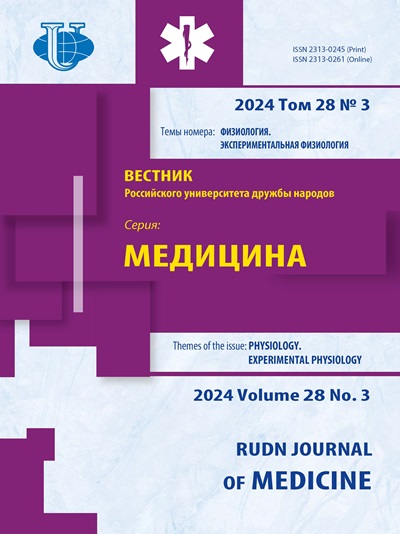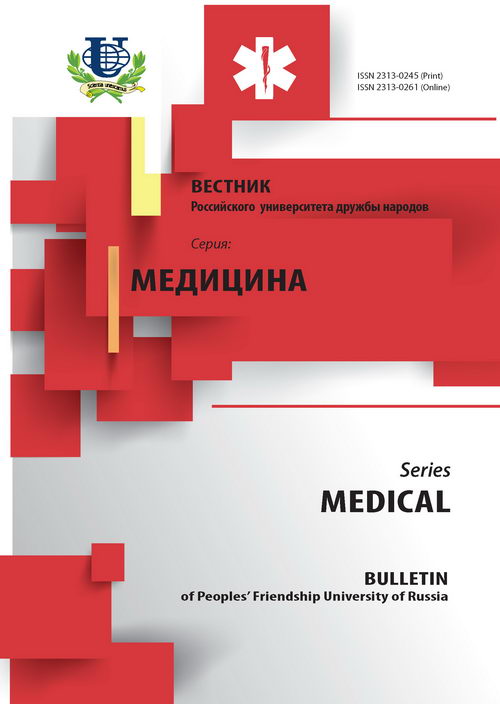Преждевременные роды у женщин с акушерской травмой промежности
- Авторы: Кострикова А.В.1, Мусалаева И.О.1, Дмитриева Е.М.1
-
Учреждения:
- Российский университет дружбы народов
- Выпуск: № 2 (2016)
- Страницы: 181-188
- Раздел: Статьи
- URL: https://journals.rudn.ru/medicine/article/view/3348
Цитировать
Полный текст
Аннотация
Частота преждевременных родов (ПР) составляет от 5 до 12% в год и имеет тенденцию к повышению за последние 20 лет. Несмотря на постоянное совершенствование знаний о причинах и механизмах развития ПР, до сих пор мир не может справиться с проблемой ПР, которая имеет гораздо больший диапазон неопределенностей [30; 31]. Одной из наиболее веских причин в развитии ПР является цервико-вагинальная инфекция, к которой относится дисбиоз влагалища. Дисбиоз влагалища - одно из самых частых инфекционных заболеваний среди женщин фертильного возраста. Одной из причин развития дисбиоза влагалища является отсутствие анатомического соотношения между составляющими тазовой диафрагмы, которое может произойти как при нормальных родах, так и при родах с видимыми и невидимыми травмами промежности [2]. Учитывая рост частоты ПР и травм промежности в родах, выявление причинно-следственной связи в этом вопросе является актуальным и нерассмотренным на данный момент.
Ключевые слова
Об авторах
Антонина Владимировна Кострикова
Российский университет дружбы народов
Email: antoninakostrikova@mail.ru
Индира Омаровна Мусалаева
Российский университет дружбы народов
Email: i700@mail.ru
Елена Михайловна Дмитриева
Российский университет дружбы народов
Email: aleksei_lukaev@mail.ru
Список литературы
- Ancel P.Y. Epidemiology of preterm birth. La Revue du Praticien. 2012. Vol. 62. Iss. 3. P. 362-365.
- Apresyan S.V., Arakelyan V.F., Abashidze A.A. The role of bacterial vaginosis in preterm labor. Obst. Gynecol. reproducti. 2013. Vol. 7. Iss. 1. P. 6-7.
- Black M., Bhattacharya S., Fairley T. et al. Of pregnancy in women using illegal drugs and in women who smoke cigarettes. Acta Obst. Gynecol. Scand. 2013. Vol. 92. Iss. 1. P. 47-52.
- Brotman R.M., Ravela J., Gajera P. et al. Vaginal microbiome of reproductive-age women. PNAS. 2011. Vol. 108. P. 4680-4687.
- Chojnacki M., Borowski D., Wielgoś M. et al. Postpartum levator ani muscle injuries. Diagnosis and treatment. Ginekol. Pol. 2015. Vol. 86. Iss. 1. P. 67-71.
- Chung S.D., Chen Y.H., Keller J.J. et al. Urinary calculi increase the risk for adverse pregnancy outcomes: a nationwide study. Acta Obstet. Gynecol. Scand. 2013. Vol. 92. Iss. 1. P. 69-74.
- Cooper N.A., Moores R. A review of the literature regarding nutritional supplements and their effect on vaginal flora and preterm birth. Curr. Opin. Obstet. Gynecol. 2014. Vol. 26. Iss. 6. P. 87-92.
- Cunnington M., Kortsalioudaki C., Heath P. Genitourinary pathogens and preterm birth. Curr. Opin. Infect. Dis. 2013. Vol. 26. Iss. 3. P. 19-30.
- Donders G.G., Van Calsteren K., Bellen G. et al. Predictive value for preterm birth of abnormal vaginal flora, bacterial vaginosis and aerobic vaginitis during thefirst trimester of pregnancy. BJOG. 2009. Vol. 116. Iss. 10. P. 1315-1324.
- Frey H.A., Klebanoff M.A. The epidemiology, etiology, and costs of preterm birth. Seminars in Fetal & Neonatal Medicine. 2016. Vol. 30. P. 1-6.
- Honda H.M., Yokoyama T., Akimoto Y., Tanimoto H. et al. The frequent shift to intermediate flora in preterm delivery cases after abnormal vaginal flora screening. Scientific reports. 2014. No. 4. P. 1-5.
- Hsieh W.C., Liang C.C., Wu D. et al. Prevalence and contributing factors of severe perineal damage following episiotomy-assisted vaginal delivery. Taiwanese Journal of Obstetrics & Gynecology. 2014. Vol. 53. P. 481-485.
- Jefferson K.K. Chapter One - The Bacterial Etiology of Preterm Birth. Adv. Appl. Microbiol. 2012. Vol. 80. P. 1-22.
- Joergensen J.S., Kjær L.K., Weile L.K., Lamontet R.F. The early use of appropriate prophylactic antibiotics in susceptible women for the prevention of preterm birth of infectious etiology. Expert. Opin. Pharmacother. 2014. Vol. 15. Iss. 15. P. 2173-2191.
- Kamisan Atan I., Gerges B., Shek K. et al. The association between vaginal parity and hiatal dimensions: A retrospective observat ional study in a tertiary urogynaecological centre. BJOG. 2015. Vol. 122. Iss. 6. P. 867-872.
- Khamoshina M.B., Tulupova M.S., Tchotchaeva A.I. et al. Imbalances in Vaginal Microbiota in Pregnant Women: Treatment and Prevention. Doctor.ru. 2012. Vol. 7. Iss. 75. P. 78-79.
- Komorowski L.K., Leeman L.M., Fullilove A.M. et al. Does a large infant head or a short perineal body increase the risk of obstetrical perineal trauma? Birth. 2014. Vol. 41. Iss. 2. P. 147-152.
- Kuć P., Laudański P., Kowalczuk O. et al. Expression of selected genes in preterm premature rupture of fetal membranes. Acta Obstet. Gynecol. Scand. 2012. Vol. 91. Iss. 8. P. 936-943.
- Kulakov V.E., Butova E.A. Obstetric traumatism of soft tissues of rodoh ways. Med. inf. Agency. 2003.
- Manuck T.A., Esplin M.S., Biggio J. et al. The phenotype of spontaneous preterm birth: application of a clinical phenotyping tool. Am. J. Obst. Gynecol. 2015. Vol. 212. Iss. 487. P. 1-11.
- Mysorekar I.U., Cao B. Microbiome in Parturition and Preterm Birth. Semin. Reprod. Med. 2014. Vol. 32. Iss. 1. P. 50-55.
- Obstetrics: National guide. 2nd edition revised and enlarged. Ed. by G.M. Savelieva, G.T. Sukhikh, V.N. Serov, V.E. Radzinsky. GEOTAR-Media, 2015.
- Orazmuradov А.A., Lukaev A.A., Yanin V.A. et al. Outcomes of Premature Birth in Women Having High Factors for Perinatal Risks. International Journal of BioMedicine. 2014. Vol. 4. Iss. 1. P. 32-35.
- Ordiyanc I.M., Arakelyan V.F. Assessment of vaginal microbiocenosis as a tool of practical gynecology. Status Praesens. 2014. Vol. 20. Iss. 3. P. 91-97.
- Ordiyantc I., Krizhanovskaya A., Toktar L. et al. Prevalence and risk factors of perineal trauma. COGI - The 13-th World Congress on Ginecology and Infertility. 2010. P. 101.
- Parker S.E., Werler M.M. Epidemiology of ischemic placental disease: A focus on preterm gestations. Seminars in perinatology. 2014. Vol. 38. P. 133-138.
- Prince A.L., Antony K.M., Chu D.M. et al. The microbiome, parturition, and timing of birth: more questions than answers. J. Reprod. Immunol. 2014.
- Radzinski V.E. About the stages of a long journey. StatusPraesens. 2014. No. 6. P. 7-9.
- Radzinskiy V.E., Khanzadyan M.L., Demura T.A. et al. The peculiarities of accumulation of collagens I and II types and elastin in the ligaments od the uterus when the prolapse genital (immunohistochemistry). Medical journal of South Russia. 2014. No. 4. P. 95-100.
- Radzinsky V.E. (ed.) Reproductive health. Tutorial. M.: Peoples’ Friendship University of Russia, 2011. Р. 727.
- Radzinsky V.E., Orazmuradov A.A., Arakelyan V.F. The biocenosis of the vagina when extremely preterm birth. Medical journal of South Russia. 2014. No. 4. P. 90-94.
- Reimers C., Staer-Jensen J., Siafarikas S. et al. Change in pelvic organ support during pregnancy and the first year postpartum: a longitudinal study. Published Online. URL: www.bjog.org. 2015
- Rîcă G.R., Badi C.P., Rîcă A.M. et al. Etiopathogenetic, clinical and histopathological aspects regarding the involvement of dental focal infection in premature births with fetal hypotrophy. Rom. J. Morphol. Embryol. 2014. Vol. 55. Iss. 3. P. 1123-1127.
- Rudneva O.D. Premature birth: a jungle of controversy. Joint discussion of problems. Women's health. Vol. 82. Iss. 6. P. 42.
- Saveleva G.M., Shalina R.I., Kurtser M.A. et al. Preterm labor as the most important problem of modern obstetrics. Obst. and gynecol. 2012. Vol. 8. Iss. 2. P. 34-37.
- Schwertner-Tiepelman N., Thakar R., Sultan A.H., Tunn R. Obstetric levator ani muscle injuries: current status. Ultrasound Obstet. Gynecol. 2012. Vol. 39, P. 372-383.
- Treloar S.A., Macones G.A., Mitchell L.E. et al. Genetic influences on premature parturition in an Australian twin sample. Twin Re. 2000. Vol. 3. P. 80-82.
- Vink J., Feltovich H. Cervical etiology of spontaneous preterm birth. Seminars in Fetal & Neonatal Medicine. 2016. Vol. 30. P. 1-7.
- Watson L.F., Rayner J.A. , King J.D. et al. Intracervical procedures and the risk of subsequent very preterm birth: a case-control study. Acta Obstet. Gynecol. Scand. 2012. Vol. 91. Iss. 2. P. 204-210.
















